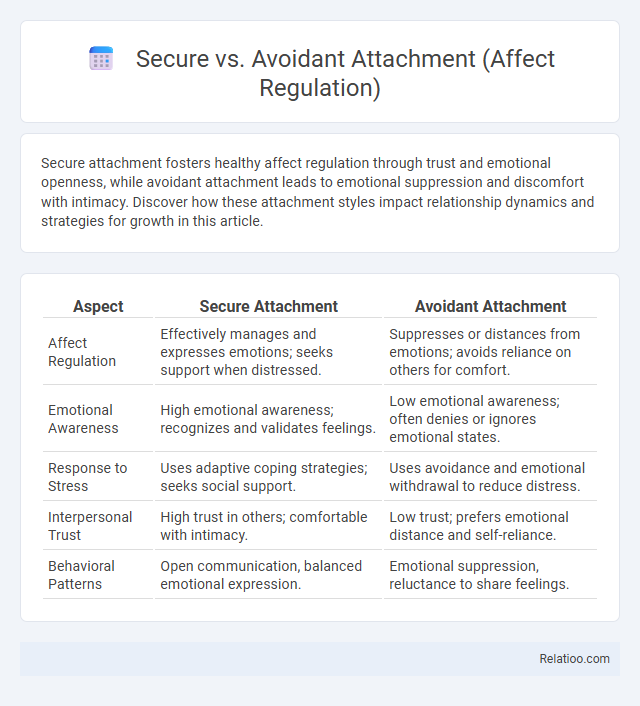Secure attachment fosters healthy affect regulation through trust and emotional openness, while avoidant attachment leads to emotional suppression and discomfort with intimacy. Discover how these attachment styles impact relationship dynamics and strategies for growth in this article.
Table of Comparison
| Aspect | Secure Attachment | Avoidant Attachment |
|---|---|---|
| Affect Regulation | Effectively manages and expresses emotions; seeks support when distressed. | Suppresses or distances from emotions; avoids reliance on others for comfort. |
| Emotional Awareness | High emotional awareness; recognizes and validates feelings. | Low emotional awareness; often denies or ignores emotional states. |
| Response to Stress | Uses adaptive coping strategies; seeks social support. | Uses avoidance and emotional withdrawal to reduce distress. |
| Interpersonal Trust | High trust in others; comfortable with intimacy. | Low trust; prefers emotional distance and self-reliance. |
| Behavioral Patterns | Open communication, balanced emotional expression. | Emotional suppression, reluctance to share feelings. |
Introduction to Attachment Styles
Secure attachment fosters healthy affect regulation by enabling you to manage emotions effectively through trust and emotional availability. Avoidant attachment often leads to suppressing feelings and difficulty seeking support, hindering emotional regulation. Understanding these attachment styles helps clarify how early relational experiences shape your affect regulation capabilities.
Understanding Secure Attachment
Secure attachment promotes effective affect regulation by enabling Your ability to recognize, express, and manage emotions healthily. In contrast, avoidant attachment often leads to suppressed emotions and difficulties in emotional closeness, hindering affect regulation. Understanding secure attachment provides crucial insights into forming stable relationships and fostering emotional resilience.
Understanding Avoidant Attachment
Individuals with avoidant attachment often suppress emotions and maintain emotional distance as their primary affect regulation strategy, leading to challenges in forming close relationships. Your ability to recognize avoidant behaviors, such as discomfort with intimacy and reluctance to depend on others, is essential for improving emotional regulation and interpersonal dynamics. Understanding how avoidant attachment patterns impact affect regulation helps tailor therapeutic approaches that foster emotional awareness and resilience.
Affect Regulation Defined
Affect regulation refers to the ability to manage and respond to emotional experiences in a healthy way, crucial for psychological well-being. Secure attachment enables effective affect regulation through consistent caregiver responsiveness, fostering emotional stability and resilience. In contrast, avoidant attachment often leads to difficulties in affect regulation, characterized by emotional suppression and discomfort with expressing vulnerability.
How Secure Attachment Influences Affect Regulation
Secure attachment fosters effective affect regulation by promoting emotional awareness and resilience, enabling you to manage stress and negative emotions constructively. Individuals with secure attachment develop healthy coping strategies through consistent, responsive caregiving that supports emotional validation and comfort. This foundation reduces emotional dysregulation and enhances interpersonal relationships by facilitating trust and empathy.
How Avoidant Attachment Influences Affect Regulation
Avoidant attachment significantly impacts affect regulation by promoting emotional suppression and distancing from distressing feelings, which hinders your ability to process emotions effectively. This attachment style encourages reliance on self-reliance and minimizing vulnerability, often leading to reduced emotional awareness and difficulties in forming intimate relationships. Understanding this dynamic is crucial for improving emotional resilience and interpersonal connections.
Emotional Expression in Secure vs Avoidant Styles
Secure attachment promotes open emotional expression, allowing individuals to effectively communicate feelings and seek support, which enhances affect regulation. Avoidant attachment suppresses emotional expression, leading to difficulties in recognizing and managing emotions, often resulting in emotional distancing to regulate affect. This contrast highlights how secure attachment fosters adaptive emotional processing, while avoidant attachment relies on emotional inhibition for affect regulation.
Coping Mechanisms: Secure vs Avoidant Individuals
Securely attached individuals utilize adaptive coping mechanisms such as seeking social support and effectively expressing emotions, leading to healthier affect regulation and emotional resilience. Avoidant attachment is characterized by emotional suppression, disengagement, and reliance on self-soothing strategies, which often result in difficulties managing stress and maintaining interpersonal connections. Your ability to regulate emotions and cope with challenges significantly depends on your attachment style, influencing long-term psychological well-being.
Impact on Relationships and Interpersonal Dynamics
Secure attachment fosters healthy affect regulation, promoting open emotional communication and trust in relationships, which strengthens interpersonal bonds. Avoidant attachment leads to suppressed emotional expression and discomfort with intimacy, often causing relational distance and miscommunication. Effective affect regulation, rooted in secure attachment, enhances empathy and conflict resolution, while avoidant patterns can hinder emotional connection and increase interpersonal tension.
Strategies for Improving Affect Regulation Across Attachment Styles
Secure attachment promotes effective affect regulation through consistent emotional responsiveness and trust, fostering adaptive coping strategies like calm reflection and problem-solving. Avoidant attachment often results in affect regulation difficulties characterized by emotional suppression and distancing, necessitating interventions that encourage emotional awareness and expression. Strategies for improving affect regulation across attachment styles include mindfulness practices, cognitive-behavioral therapy targeting maladaptive beliefs, and building secure relationships to enhance emotional safety and resilience.

Infographic: Secure vs Avoidant Attachment (Affect Regulation)
 relatioo.com
relatioo.com